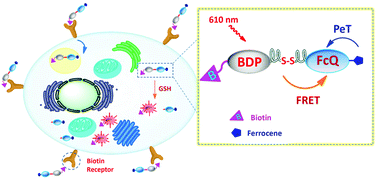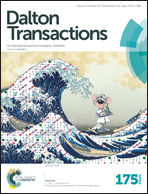A biotin-conjugated glutathione-responsive FRET-based fluorescent probe with a ferrocenyl BODIPY as the dark quencher†
Abstract
An efficient ferrocenyl BODIPY based dark quencher has been developed and employed to construct a FRET-based fluorescent probe that contains a biotin moiety as a potential directing ligand for cancer cells and a glutathione-cleavable disulfide linker connecting the quencher and a distyryl BODIPY fluorophore. This molecular probe is deactivated in the native form through FRET followed by intramolecular charge transfer due to the ferrocenyl unit. However, upon interaction with glutathione in phosphate buffered saline and inside cancer cells, the fluorescence emission is significantly increased due to detachment of the fluorophore from the quencher. As shown by flow cytometry, this probe also exhibits preferential uptake by the biotin-receptor-expressing A549 human lung adenocarcinoma epithelial cells over the Chinese hamster ovary CHO-K1 cells used as the negative control. On the basis that both biotin receptor and GSH level are often overexpressed or elevated in cancer cells, this dual functional fluorescent probe serves as a promising agent for cancer imaging.


 Please wait while we load your content...
Please wait while we load your content...